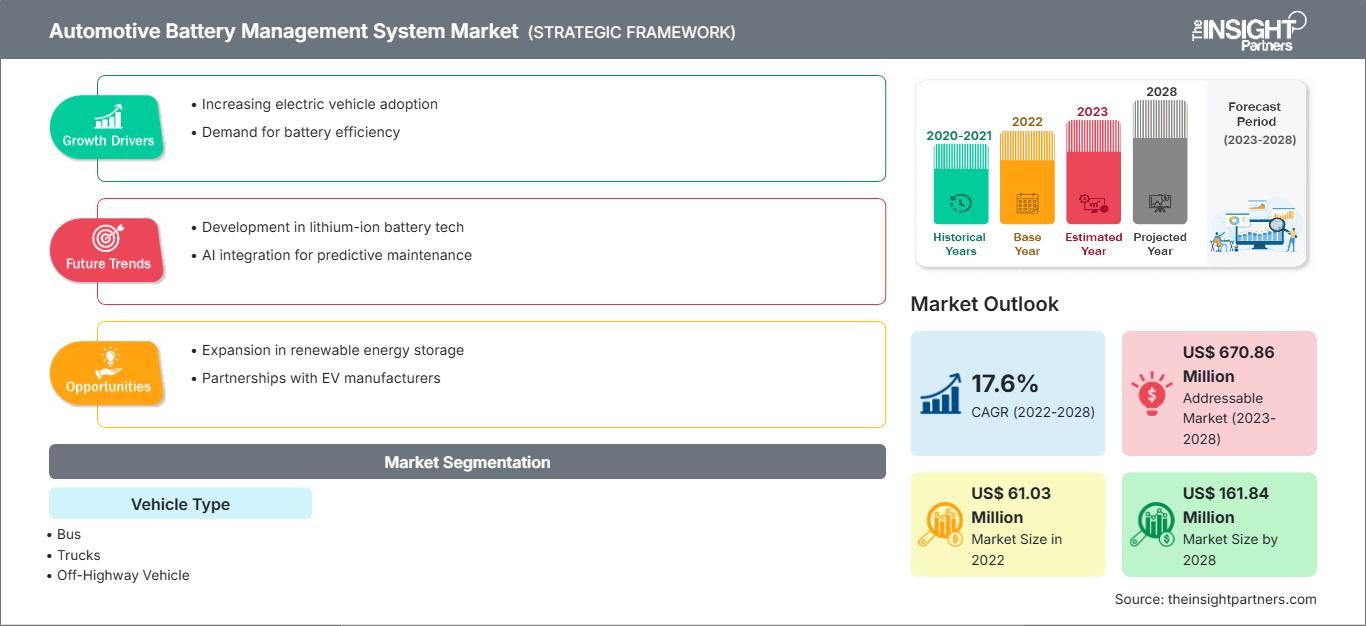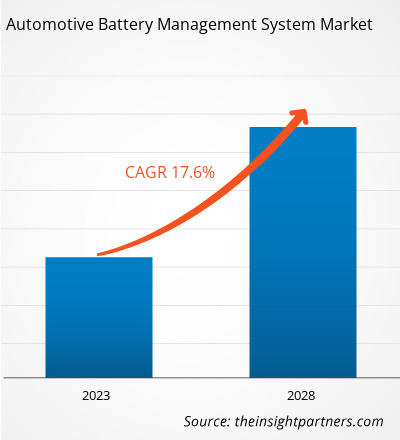汽车电池管理系统市场预计将从2022年的6103万美元增长;预计2022年至2028年的复合年增长率将达到17.6%。
电池管理系统用于管理高压混合动力汽车和电动汽车中使用的电池。电动汽车制造商和电池组制造商将电池管理系统集成到锂离子电池中,以保护电池组。电动汽车的整体电池系统由多个组件组成,例如电池模块、传感器、控制器、热管理系统和电池管理系统。随着人们对环境保护的关注度不断上升以及政府为减少排放而采取的积极举措,预计在 2022 年至 2028 年的预测期内,对电动和混合动力汽车的需求将以惊人的速度增长。这反过来将推动汽车电池管理系统市场的增长。
全球电动汽车和电池组行业的特点是存在一些非常知名且财力雄厚的公司,例如三菱、日产和特斯拉。因此,汽车电池管理系统市场中买家的议价能力相当高。由于电动汽车的持续研发,加上汽车电池管理系统市场的快速增长,预计买家的议价能力在 2019 年至 2027 年期间将保持较高水平。汽车电池管理系统市场中的主要公司在为其车辆规划电池系统时采用不同的策略。预计技术领域的不断进步将给电池管理系统供应商带来压力,迫使他们适应变化以保持其市场地位。鉴于这一事实,买家也倾向于根据其特定要求和 BMS 提供商的技术组合在一段时间内更换 BMS 提供商。
自定义此报告以满足您的要求
您将免费获得任何报告的定制,包括本报告的部分内容,或国家级分析、Excel 数据包,以及为初创企业和大学提供超值优惠和折扣
汽车电池管理系统市场: 战略洞察

- 获取本报告的主要市场趋势。这个免费样本将包括数据分析,从市场趋势到估计和预测。
您将免费获得任何报告的定制,包括本报告的部分内容,或国家级分析、Excel 数据包,以及为初创企业和大学提供超值优惠和折扣
汽车电池管理系统市场: 战略洞察

- 获取本报告的主要市场趋势。这个免费样本将包括数据分析,从市场趋势到估计和预测。
COVID-19 疫情对汽车电池管理系统市场份额的影响
2020 年,COVID-19 疫情在全球经济高峰期爆发,对其造成了巨大冲击,阻碍了制造业的商业活动。疫情爆发前,由于电动汽车销量增加、可支配收入激增以及信贷和融资的便利,汽车电池管理系统市场份额正在大幅增长。此外,对电动汽车开发的重大投资举措推动了对汽车电池管理系统的需求。根据国际清洁交通理事会的数据,2021 年全球电动汽车销量达到创纪录的 690 万辆,比 2020 年增长 107%。然而,COVID-10 疫情的爆发减缓了对电动汽车的投资和生产。在疫情爆发初期,这场危机严重限制了所有扰乱汽车电池管理系统市场的商业交易、合作和伙伴关系。疫情的出现阻碍了 2020 年 2 月的汽车销售;此外,截至 4 月份,美国和欧洲的汽车销量分别下降了 47% 和 80%。根据 Statista 的报告,2020 年全球汽车销量下降至 6380 万辆,2021 年缓慢回升至 6600 万辆。
市场洞察 — 汽车电池管理系统市场
电动汽车销量增长和电动汽车基础设施扩张
由于人们对环境保护的日益关注以及政府支持采用低排放和零排放汽车的政策,电动汽车 (EV) 销量正在快速增长。政府提供的补贴和退税鼓励制造商扩大生产规模。根据《全球电动汽车展望》,2021 年电动汽车(包括全电动和插电式混合动力汽车)的销量达到 660 万辆。同年,中国的销量飙升至 330 万辆,约占全球销量的一半。此外,欧洲的电动汽车销量增长了 65%,达到 230 万辆,而美国的销量在 2021 年翻了一番,达到 63 万辆。因此,充电基础设施投资的增加和政府优惠政策的增多正在推动电池制造规模的扩大,从而增强了对汽车电池管理系统市场的需求。
基于车辆类型的洞察
根据车辆类型,汽车电池管理系统市场细分为公共汽车、卡车和非公路用车。到 2022 年,由于公共汽车越来越多地采用电池来减轻碳排放,公共汽车市场占据了汽车电池管理系统市场的最大份额。此外,预计卡车市场在预测期内的复合年增长率最高。由于越来越多的举措追求最佳电池性能和监控电池组温度,电动公共汽车制造商对电池管理系统的需求正在显着增加。此外,各国对电动校车的需求也在增长,以减少碳排放,这也使得电动校车制造商能够扩大生产线。多个国家的政府正在采用绿色技术公交车,这刺激了对电动客车的需求,从而推动了汽车电池管理系统市场的增长。
汽车电池管理系统市场区域洞察
The Insight Partners 的分析师已详尽阐述了预测期内影响汽车电池管理系统市场的区域趋势和因素。本节还讨论了北美、欧洲、亚太地区、中东和非洲以及南美和中美洲的汽车电池管理系统市场细分和地域分布。
汽车电池管理系统市场报告范围
| 报告属性 | 细节 |
|---|---|
| 市场规模 2022 | US$ 61.03 Million |
| 市场规模 2028 | US$ 161.84 Million |
| 全球复合年增长率 (2022 - 2028) | 17.6% |
| 历史数据 | 2020-2021 |
| 预测期 | 2023-2028 |
| 涵盖的领域 |
By 车辆类型
|
| 覆盖地区和国家 | 北美
|
| 市场领导者和主要公司简介 |
|
汽车电池管理系统市场参与者密度:了解其对业务动态的影响
汽车电池管理系统市场正在快速增长,这得益于终端用户需求的不断增长,而这些需求的驱动因素包括消费者偏好的不断变化、技术进步以及对产品优势的认知度不断提高。随着需求的增长,企业正在扩展产品线,不断创新以满足消费者需求,并抓住新兴趋势,从而进一步推动市场增长。

- 获取 汽车电池管理系统市场 主要参与者概述
汽车电池管理系统市场的参与者主要致力于开发先进高效的产品。
- 2021年8月,电池专家Varta与开发和生产服务提供商大陆工程服务公司(CES)宣布合作。作为首个试点项目的一部分,两家合作伙伴合作开发了一种可更换的48伏电池组,适用于功率为10千瓦及以上的电动两轮车。
- 2021年6月,为电动汽车领域打造卓越热管理系统的以色列公司Carrar宣布,市场领导者和尖端热管理解决方案的创造者Gentherm成为其种子轮融资的领投者。
汽车电池管理系统市场分为五大区域——北美、欧洲、亚太地区(APAC)和世界其他地区。2022年,亚太地区以可观的收入份额占据市场主导地位,其次是欧洲。此外,预计亚太地区将在2022年至2028年期间实现市场最高复合年增长率。大陆集团、德纳有限公司、GENTHERM、Hanon Systems、Mahle GmbH、恩智浦半导体、瑞萨电子株式会社、罗伯特·博世有限公司、法雷奥和马瑞利控股有限公司是汽车电池管理系统市场的主要参与者。市场报告提供了详细的市场洞察,有助于主要参与者制定未来几年的增长战略。
- 历史分析(2 年)、基准年、预测(7 年)及复合年增长率
- PEST和SWOT分析
- 市场规模、价值/数量 - 全球、区域、国家
- 行业和竞争格局
- Excel 数据集
近期报告
相关报告
客户评价
购买理由
- 明智的决策
- 了解市场动态
- 竞争分析
- 客户洞察
- 市场预测
- 风险规避
- 战略规划
- 投资论证
- 识别新兴市场
- 优化营销策略
- 提升运营效率
- 顺应监管趋势




















 获取免费样品 - 汽车电池管理系统市场
获取免费样品 - 汽车电池管理系统市场